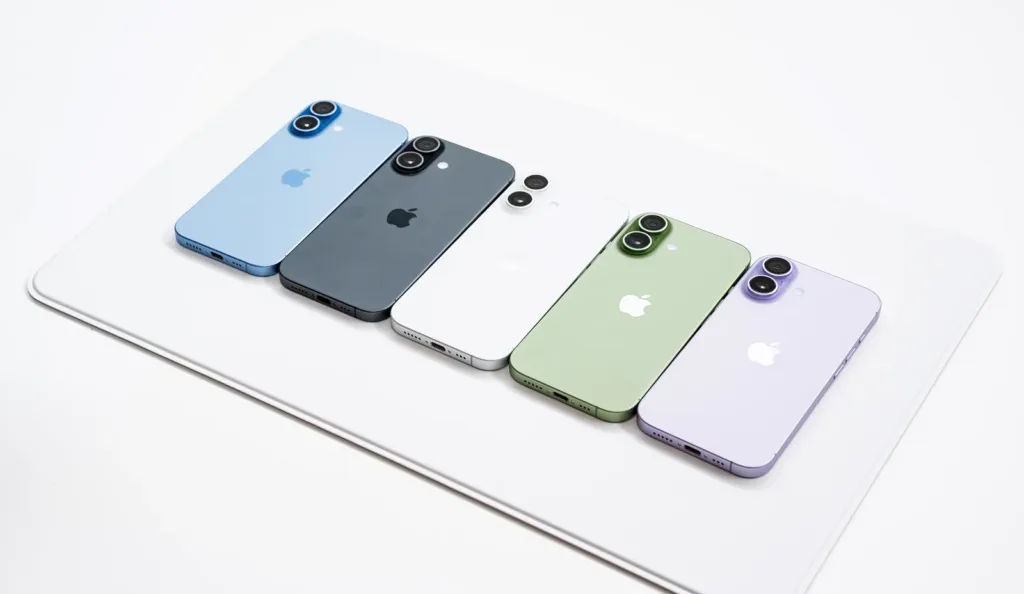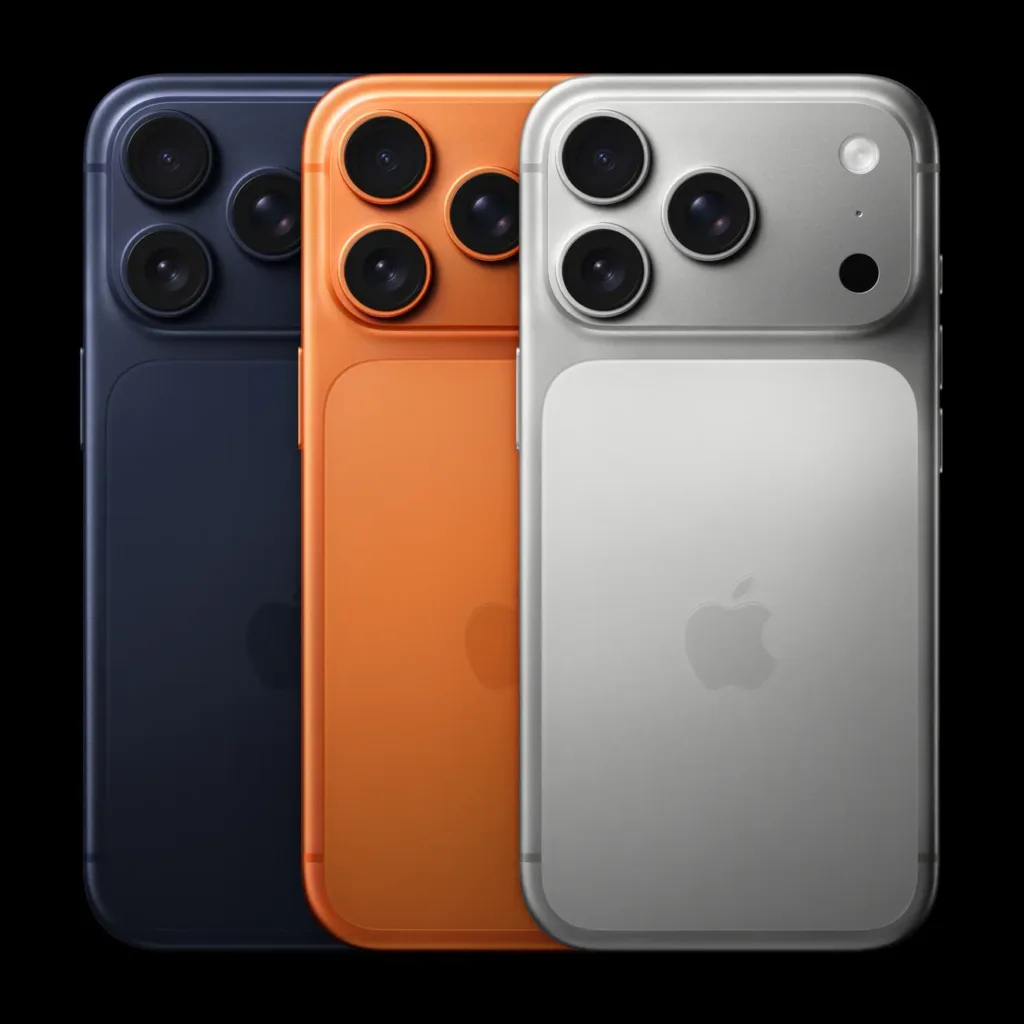Table of Contents
iPhone 17 Design, Display, and New Air Model
Apple’s September “Awe Dropping” event gave U.S. customers their first official look at the iPhone 17 lineup. At Squaredtech, we see this launch as one of Apple’s biggest updates in years, not because of radical cosmetic changes, but because of the deep technical improvements across the entire family of devices.
The standard iPhone 17 debuts with a 6.3-inch Super Retina XDR display, complete with ProMotion adaptive refresh rates up to 120Hz. This means smoother animations, more responsive scrolling, and better gameplay performance. Apple also confirmed that the always-on display, previously limited to the Pro line, is now part of the base iPhone 17. Users can check time, widgets, and notifications without waking their phone, while the screen dynamically lowers refresh rates to save battery.
Brightness also gets a serious bump. The iPhone 17 now reaches a peak brightness of 3,000 nits, compared to the 2,000 nits of the iPhone 16. For U.S. users who often use phones outdoors, especially in bright sunlight, this means sharper visuals and clearer text even at midday. Apple also rolled out Ceramic Shield 2 glass, which promises triple the scratch resistance of the last generation. The company also added a seven-layer anti-reflective coating, making colors and videos look vivid under tough lighting.
But the real surprise is the new iPhone 17 Air. Instead of continuing with the iPhone Plus line, Apple has introduced a thinner and lighter model. The Air is just 5.6 millimeters thin and weighs only 165 grams, making it the thinnest iPhone Apple has ever created. Despite its slim profile, it packs a 6.6-inch ProMotion display and comes with a titanium-aluminum frame for durability. This shift shows Apple is betting big on thin design, competing directly with rivals like Samsung’s Galaxy S25 Edge and Honor’s Magic V5.
Read More About Our Article of Apple iPhone 17 Production Shifts to India: A Game Changing Move for Apple and the US Market Published on August 27th, 2025 SquaredTech
Here’s how the iPhone 17 model lineup breaks down for U.S. buyers:
| Model | Starting Price | Display Size | Key Feature | Storage Options |
|---|---|---|---|---|
| iPhone 17 | $799 | 6.3 inches | 3,000 nits brightness, Ceramic Shield 2 | 256GB, 512GB |
| iPhone 17 Air | $999 | 6.6 inches | Slimmest iPhone ever, titanium frame | 256GB, 512GB |
| iPhone 17 Pro | $1,099 | 6.3 inches | Camera Plateau, vapor cooling | 256GB, 1TB |
| iPhone 17 Pro Max | $1,199 | 6.9 inches | 8X optical zoom, 8K recording | 256GB, 1TB |
iPhone 17 Cameras, Performance, and Software

Apple is making big claims about photography with the iPhone 17 series. For the first time, the base iPhone 17 comes with all 48MP sensors, including a Fusion Main camera, a 48MP UltraWide lens, and a built-in 2X telephoto option. This is a huge leap from earlier generations, where only the Pro models enjoyed the highest-resolution sensors.
The selfie camera also got a redesign. Apple’s 18MP Center Stage front camera now uses a square sensor, which means selfies can be taken in both portrait and landscape orientation without flipping the phone. U.S. social media users who love TikTok and Instagram will notice sharper selfies and smoother video. The camera also supports 4K HDR recording with ultra-stabilization. With Dual Capture, you can record with front and back cameras at the same time—perfect for vloggers or creators.
On the Pro and Pro Max side, Apple introduced a brand-new Camera Plateau design, replacing the square camera bump with a wide horizontal bar. The highlight is the 48MP telephoto lens, offering 1x, 2x, 4x, and 8x optical zoom, along with 8K video recording. Users can also digital zoom up to 40x, rivaling Samsung’s Galaxy S23 Ultra in long-distance photography.
Performance takes a giant leap forward with the A19 chip built on 3nm technology. Apple claims the 6-core CPU is 90% faster than the iPhone 14’s A15 Bionic, while the 5-core GPU doubles graphical power. For gamers, this means smoother frame rates and console-like visuals. Importantly, the A19 chip includes neural accelerators for generative AI, giving the iPhone 17 the ability to run Apple Intelligence features directly on the device.
At launch, the iPhone 17 series ships with iOS 26. This update introduces Adaptive Power Mode, which learns from user habits and manages battery efficiency automatically. Apple Intelligence features are also expanding, including real-time text and audio translations, upgraded Visual Intelligence, and accessibility improvements for users with low literacy or disabilities.
Squaredtech’s analysis suggests that Apple is positioning the iPhone 17 as not just a smartphone, but as a foundation for its AI ecosystem. For U.S. users, this means the iPhone 17 could be the first iPhone where AI is not just a feature, but a core part of the experience.
Read More About Our Article of iPhone 17 Pro Leaks Reveal 14 Major Upgrades You Can’t Ignore Published on July 7th, 2025 SquaredTech
Here’s a quick comparison of iPhone 16 vs iPhone 17 upgrades:
| Feature | iPhone 16 | iPhone 17 |
|---|---|---|
| Peak Brightness | 2,000 nits | 3,000 nits |
| Front Camera | 12MP | 18MP square sensor |
| Battery Life | 22 hours video | 30 hours video |
| Charging | 50% in 30 min | 50% in 20 min |
| Base Storage | 128GB | 256GB |
| AI Support | Limited | Built-in Gen AI |
iPhone 17 Prices, Models, and U.S. Launch Timeline
Apple kept the base price of the iPhone 17 at $799, which is the same as the iPhone 16. That decision is significant for U.S. buyers, especially given rising prices in tech. The Air comes in at $999, while the Pro and Pro Max will cost $1,099 and $1,199. Storage now starts at 256GB across the board, removing the 128GB option entirely.
Color options also expand this year. The iPhone 17 comes in Lavender, Mist Blue, Black, White, and Sage, while the Air is available in Black, White, Light Gold, and Sky Blue. The Pro and Pro Max offer bold finishes in Blue, Orange, and Silver.

Preorders for all iPhone 17 models begin on Friday, September 12, with U.S. retail availability starting Friday, September 19. Apple is offering up to $700 in trade-in credits for users upgrading from an iPhone 13 or newer. This trade-in policy is especially important for cost-conscious buyers who want the new features without paying full retail.
Squaredtech notes that Apple’s pricing strategy reflects confidence in customer loyalty. By holding the base model at $799 while introducing a new premium Air option, Apple creates a wider pricing ladder that appeals to both mainstream and high-end buyers. For U.S. carriers, this will likely translate into aggressive promotions and bundled offers by the holiday season.
Conclusion: Is the iPhone 17 Worth It?
After analyzing the launch, Squaredtech believes the iPhone 17 is Apple’s most convincing upgrade in years. While its exterior design remains familiar, the inside tells a different story: brighter displays, stronger glass, faster charging, AI-powered performance, and the first all-48MP camera lineup.
The iPhone 17 Air will generate the most conversation. Its ultra-thin design is a bold experiment that positions Apple as a leader in premium hardware aesthetics. However, the Pro and Pro Max remain the powerhouses for professionals and creators, thanks to their expanded zoom and recording capabilities.
For U.S. customers, the unchanged $799 entry point is a clear win. The combination of trade-in credits, stronger features, and long-term AI potential makes the iPhone 17 a safe but exciting upgrade. At Squaredtech, we see Apple’s 2025 strategy as a balance between innovation and familiarity, giving every type of buyer—mainstream, design-focused, or pro-level—a reason to consider the jump.
If history is any guide, this fall’s iPhone 17 launch could be Apple’s strongest since the iPhone X, reshaping how Americans use their phones for AI, photography, and entertainment.
Stay Updated: Mobile


